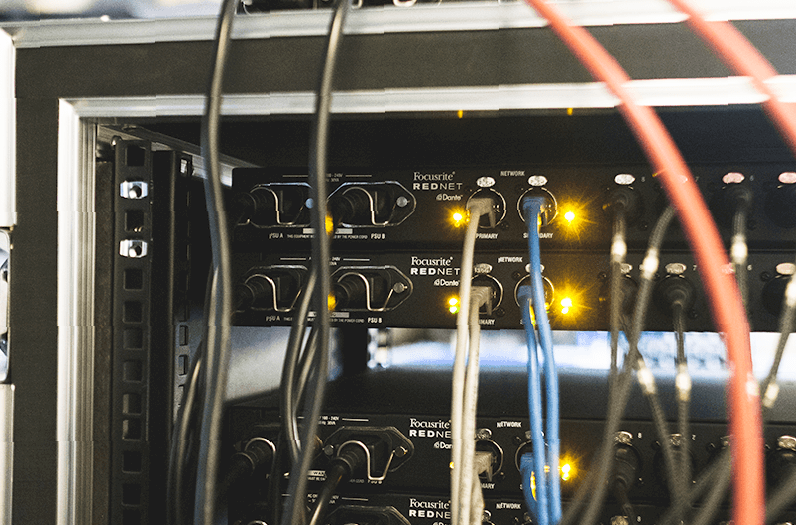Working in audio these days, it seems impossible to avoid the topic of audio networking protocols. Let’s break down what these protocols mean as well as how and when we can use them.
In the modern digital world, distributing audio over Ethernet (AoE for short) is fast becoming a standard. The idea that we can send audio signal over a single Ethernet cable is amazing and a relatively new phenomenon.
It wasn’t that long ago that dozens of copper cables weighing hundreds of pounds were required to transport audio from front of house to the stage and back. Now it takes a single 100-foot spool of Ethernet cable to send upwards of 256 channels of audio.
In addition, AoE is designed to be high in quality and low in latency (a short period of delay), requiring a high-performance local area network (LAN). Be sure to check out Dan Leafblad’s ongoing article series on the essentials of audio networking (here) for more information.
Getting the audio onto an Ethernet cable itself isn’t quite as obvious as simply sending it over copper cables like XLR. We need what is called a protocol – an audio over Ethernet protocol. Check out a comparison of numerous protocols on Wikipedia (here) and you can see how many options there are.
A protocol is essentially a way of packing and unpacking an audio signal in a specific way. They work on different layers. For example, Layer 2 is general point-to-point while Layer 3 is typically IP-address based (Dante is Layer 3, for instance).
Layer 2, while not being as freely assignable as Layer 3, provides the benefit of fewer variables and fewer possible clocking issues, among other things. Think of Layer 2 as being “plug and play” and Layer 3 as being “overtly flexible.”
Proprietary & Non-Proprietary
OK, what do these terms even mean? A proprietary protocol is specific to a manufacturer, written and implemented so that it only works with that manufacturer’s own gear.
Meanwhile, a non-proprietary protocol is developed by a group or committee, so no single entity owns it. It’s a way to standardize AoE without having to commit to one particular manufacturer.
On its face, it would seem that non-proprietary protocols such as AES50, AES67 and AVB are better options since no one owns them. However, and unfortunately, AoE has not yet been fully standardized nor fully accepted among manufacturers.
The audio industry has not come to a final conclusion and the battle has been waging on for years. The only way non-proprietary protocols will become standardized is if enough manufacturers get on board to create enough equipment that can work together on the protocol.
Let’s think about that for a moment, though. Is it in the best interest of manufacturers to allow their gear to work with anything and everything? Keep in mind that manufacturers are in business; in other words, they’re in it for the money.
It’s also worth noting that there’s a vast number of product groups – loudspeakers, consoles, microphones, processors, amplifiers and many more. Getting all these parties to work together and agree to do one or two things the same is not so simple.
On One Hand…
I prefer proprietary protocols. (I know, I’m selling out for “the man,” but hear me out.) When we select a proprietary protocol (Dante, SoundGrid, gigaACE, etc.) we’re choosing something that works best for our specific audio equipment.
Further, when manufacturers create their own protocol, they have complete control over it and are able to do some things that can’t be done when held to a “free-for-all” protocol. Instead of making the gear fit the protocol, they’re creating the protocol to fit the gear.
Manufacturers can also choose to partner. Look at Audinate (Dante) and what the company has done for the audio field. They’ve gone on to partner with many, many manufacturers so that their equipment easily connects via AoE without having to build a protocol from scratch themselves.

Dante also allows us to mix equipment brands with relative ease and utilize star topology for things like digital splits or even redundancy. Granted, it does take an extra card slot or an extra chip, but the return on investment and R&D time means that more people have more access.
Another example is Waves SoundGrid allows us to use the tools we’ve been using in studios for years in the live sound world, a feat that is becoming easier now that audio technology is moving into the future. It also allows us to easily record massive amounts of multitracks with a single cable and only a few limitations.
On The Other Hand…
If the world is full of only proprietary protocols for AoE, it can make it difficult to not only mix and match brands, but to expand. And for some manufacturers, their proprietary protocols aren’t always the best.
In the aforementioned Wikipedia page, you can find many defunct protocols that you perhaps heard about 10 years ago but are no longer part of the biz. Similar to barbeque joints in Kansas City, the field tends to weed out those that aren’t up to snuff. So the good news is that the good stuff lasts. The bad news is that we can’t entirely be sure at first.
Additionally, non-proprietary protocols are often less costly to implement. Because there’s no licensing required from other companies who’ve built something from the ground up, equipment is often more affordable.
If you’re looking at upgrading equipment, or planning on a new-build in the future, or are retrofitting existing equipment, I recommend spending a some time to do some research on what sorts of protocols your favorite gear supports, the pros and cons of each protocol specifically (such as channel count, resolution, and more,) and what you may want to do not five years in the future, but 10 years. Only then decide on a protocol – and stick with it.
Non-proprietary is a great idea, but the execution has proven to be a bit more complicated. In my experience, I prefer working within a proprietary protocol between my I/O and the outputs of my console, then I prefer going non-proprietary into the loudspeakers. Some engineers and techs may feel differently, and that’s just another reason why this conversation continues.
Someday, we may all be non-proprietary. But for now, I’m enjoying all the good things about proprietary and all the access with non-proprietary. Win-win.




















